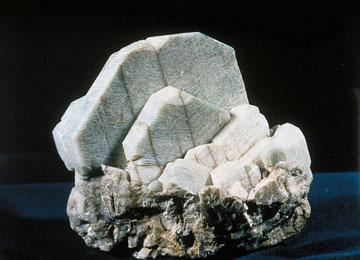Crystal System Triclinic Specific Gravity 2.5-2.6 | Relief Low negative relief | |
 | ||
Habit/Shape Can be anhedral or euhedral. Grains are commonly elongate with a tabular appearance. May contain lamellae which formed from exsolved albite. Cleavage/Fracture Habit Has perfect cleavage parallel to {001} and good cleavage on {010}. Cleavages intersect at 90°41'. It can be difficult to see cleavage in thin section due to microcline's low relief. Refractive Index nα = 1.514 - 1.529 nβ = 1.518 - 1.533 nγ = 1.521 - 1.539 | ||
Microcline (KAlSi3O8) is an important igneous rock-forming tectosilicate mineral. It is a potassium-rich alkali feldspar. Microcline typically contains minor amounts of sodium. It is common in granite and pegmatites. Microcline forms during slow cooling of orthoclase; it is more stable at lower temperatures than orthoclase. Sanidine is a polymorph of alkali feldspar stable at yet higher temperature. Microcline may be clear, white, pale-yellow, brick-red, or green; it is generally characterized by cross-hatch twinning that forms as a result of the transformation of monoclinic orthoclase into triclinic microcline.
Microcline may be chemically the same as monoclinic orthoclase, but because it belongs to the triclinic crystal system, the prism angle is slightly less than right angles; hence the name "microcline" from the Greek "small slope." It is a fully ordered triclinic modification of potassium feldspar and is dimorphous with orthoclase. Microcline is identical to orthoclase in many physical properties; it can be distinguished by x-ray or optical examination; viewed under a polarizing microscope, microcline exhibits a minute multiple twinning which forms a grating-like structure that is unmistakable.
Perthite is either microcline or orthoclase with thin lamellae of exsolved albite.
Amazon stone, or amazonite, is a green variety of microcline. It is not found anywhere in the Amazon Basin, however. The Spanish explorers who named it apparently confused it with another green mineral from that region.
The largest documented single crystals of microcline were found in Devils Hole Beryl Mine, Colorado, US and measured ~50x36x14 m. This could be one of the largest crystals of any material found so far.
Microcline is commonly used for the manufacturing of porcelain.
